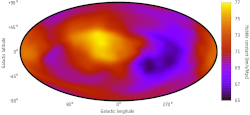HEAPOW: A Strangely Growing Universe? (2022 Jul 18)
Posted: Tue Jul 19, 2022 8:23 pm
 HEAPOW: A Strangely Growing Universe? (2022 Jul 18)
HEAPOW: A Strangely Growing Universe? (2022 Jul 18)
A fundamental tenet which guides the study of the origin and evolution of the Universe, is that, on large scales, the Universe is isotropic, the same in any direction you care to look. It's difficult to imagine a reason why this wouldn't be the case - why would any particular direction in the Universe be special? And the universe appears to be isotropic, according to cosmic microwave maps from COBE, WMAP, and Planck, and while there may be a few discrepancies, most have relatively mundane explanations (like the "CMB dipole" produced by the motion of our solar system relative to the cosmic microwave background, or the mysterious "cold spot" which may be associated with a "supervoid" in intergalactic space). But in science, hypotheses must be tested to the largest extent possible. Recently, scientists have attempted to test the hypothesis of Universal isotropy by measuring the X-ray properties of clusters of galaxies all around the sky. Clusters of galaxies are the largest gravitationally bound structures known, and are bright X-ray sources due to the extremely hot, million-degree gas that fills the space between them (and which contains much more mass than all the stars and gas in the cluster galaxies themselves). Studies have shown that the hotter this X-ray emitting intracluster gas is, the more luminous it is. But a new study showed an unexpected result: in some regions of the sky, the clusters were apparently fainter than predicted by the X-ray temperature-brightness relation. At face value, this could mean that the Universe is expanding faster in some directions than others. The derived difference in expansion rate is shown in the image above, where colors show the expansion rate on a map of the entire sky. The significance of the result is still too low to cause a widespread revolutionary change in our understanding of the Universe. New observations using eROSITA X-ray observations of galaxy clusters, and other observations from other telescopes, will help shed more understanding of this puzzling result.
Rethinking Cosmology: Universe Expansion May Not Be Uniform
ESA | Space Science | XMM-Newton | 2020 Apr 08
Probing Cosmic Isotropy with a New X-ray Galaxy Cluster Sample through the LX—T Scaling Relation ~ K. Migkas et al
- Astronomy & Astrophysics 636:A15 (Apr 2020) DOI: 10.1051/0004-6361/201936602
- arXiv > astro-ph > arXiv:2004.03305 > 07 Apr 2020
viewtopic.php?t=40440
| << Previous HEAPOW | High Energy Astrophysics Picture of the Week | Next HEAPOW >> |